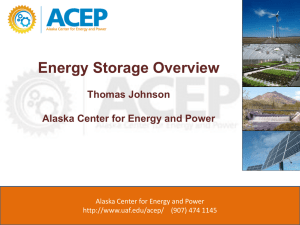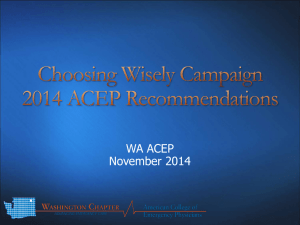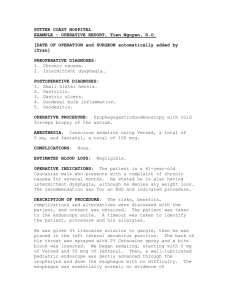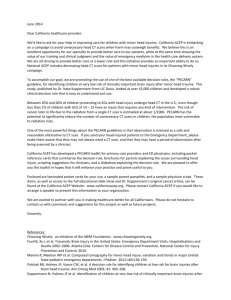DRAFT Minutes () - Renewable Energy Alaska Project
advertisement
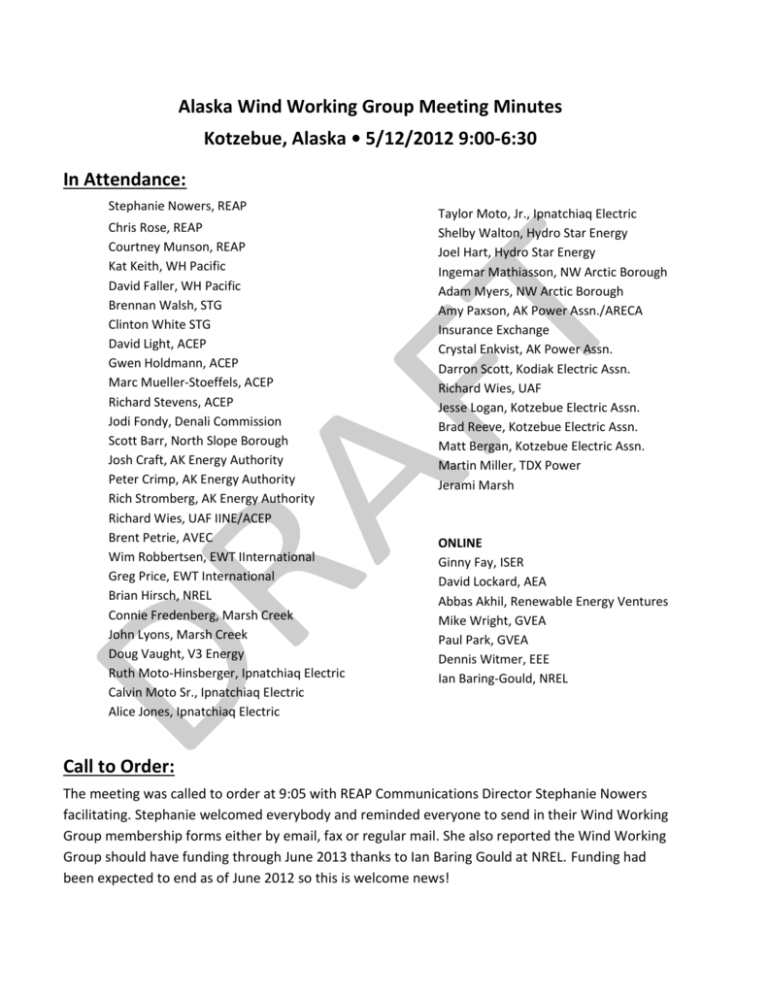
Alaska Wind Working Group Meeting Minutes Kotzebue, Alaska • 5/12/2012 9:00-6:30 In Attendance: Stephanie Nowers, REAP Chris Rose, REAP Courtney Munson, REAP Kat Keith, WH Pacific David Faller, WH Pacific Brennan Walsh, STG Clinton White STG David Light, ACEP Gwen Holdmann, ACEP Marc Mueller-Stoeffels, ACEP Richard Stevens, ACEP Jodi Fondy, Denali Commission Scott Barr, North Slope Borough Josh Craft, AK Energy Authority Peter Crimp, AK Energy Authority Rich Stromberg, AK Energy Authority Richard Wies, UAF IINE/ACEP Brent Petrie, AVEC Wim Robbertsen, EWT IInternational Greg Price, EWT International Brian Hirsch, NREL Connie Fredenberg, Marsh Creek John Lyons, Marsh Creek Doug Vaught, V3 Energy Ruth Moto-Hinsberger, Ipnatchiaq Electric Calvin Moto Sr., Ipnatchiaq Electric Alice Jones, Ipnatchiaq Electric Taylor Moto, Jr., Ipnatchiaq Electric Shelby Walton, Hydro Star Energy Joel Hart, Hydro Star Energy Ingemar Mathiasson, NW Arctic Borough Adam Myers, NW Arctic Borough Amy Paxson, AK Power Assn./ARECA Insurance Exchange Crystal Enkvist, AK Power Assn. Darron Scott, Kodiak Electric Assn. Richard Wies, UAF Jesse Logan, Kotzebue Electric Assn. Brad Reeve, Kotzebue Electric Assn. Matt Bergan, Kotzebue Electric Assn. Martin Miller, TDX Power Jerami Marsh ONLINE Ginny Fay, ISER David Lockard, AEA Abbas Akhil, Renewable Energy Ventures Mike Wright, GVEA Paul Park, GVEA Dennis Witmer, EEE Ian Baring-Gould, NREL Call to Order: The meeting was called to order at 9:05 with REAP Communications Director Stephanie Nowers facilitating. Stephanie welcomed everybody and reminded everyone to send in their Wind Working Group membership forms either by email, fax or regular mail. She also reported the Wind Working Group should have funding through June 2013 thanks to Ian Baring Gould at NREL. Funding had been expected to end as of June 2012 so this is welcome news! Alaska Renewable Energy Grant Fund update from Chris Rose, REAP Chris reported the good news that the legislature approved a 10-year extension to 2023 of the Renewable Energy Grant Fund with intent language to put in $50 million a year to the Fund. This was a priority for the Alaska Wind Working Group. However, the $50 million is just intent language and he urged members to continue to contact legislators and the Governor to remind them about the importance of fully funding the Fund. For example, this year, $43 million was requested in funding, but only $25 million was approved. Also discussed was a recent independent third-party evaluation of the Renewable Energy Grant Fund by the Vermont Energy Investment Corporation. The first part of the evaluation looked at processes of the Fund and several recommendations were made for improvement in how the program could be administered. A second part of the report will evaluate the impacts of the Fund and is due out in June. ·Chris reported the legislature has created a new $125 million loan fund through the Alaska Industrial Development & Energy Authority (AIDEA) to help finance energy projects that will include direct loans and loan guarantees. He also discussed the need for a cabinet level position for energy in the state to help unify the state's various domestic energy efforts and noted that is an issue that REAP is currently working on. Unalakleet Wind Modeling update from Rich Stromberg, AEA Rich showed how data being collected from Unalakleet’s wind turbines can be used to better understand performance characteristics of the wind farm. Key findings are the voltage rise on the grid when the six turbine’s output increases on the 4,160-volt transmission line, how the wind turbines compensate for the voltage rise and a bi-modal power distribution when wind speeds are above 15 meters per second. AEA offers this kind of analysis at no charge to Alaska wind system operators who send their SCADA data to AEA. Wind Report Card Discussion from Josh Craft, AEA Josh gave an overview of AEA’s ongoing work to model and evaluate wind project performance in the state, and the results so far. He discussed the goal is to improve systems, better predict performance and identify trends/problems that may need addressing. Discussion ensued about the best measure of system performance and questions were raised about whether the data is shared with the legislature. Josh said the data is used internally by staff and with operators. Stephanie noted the Wind Working Group meeting had actual attendance that exceeded predicted attendance. Panel Discussion: Turbine type use in AK (Moderator: Kat Keith) Discussion of the different types and experience with turbines in use in Alaska including, Vestas, GE, EWT, and Northern Power Systems. Next Year’s Priorities & Goals Each of those attending identified their two top hurdles to wind development in Alaska, and their top two priorities for the Wind Working Group for the coming year. The four top hurdles identified were: Financing, Data, Human Capacity/O&M, and Technical/Integration Issues. The three top priorities were: Funding, Data, and Sharing of Information. (See the full list of hurdles and priorities at the bottom of minutes.) Greg Price mentioned leveraged tax equity as an option for alternative financing, and was later volunteered while out of the room to provide a write up to the group on possible potential financing options. (Thanks Greg!) Training was also discussed, and it was noted AVTEC in Seward now has their Northwind 100 up and running. Presentation by Kotzebue Mayor Martha Whiting Mayor Whiting noted her region is challenged with some of the highest energy costs in the state and highest suicide rates, and is losing people from the villages. She urged the group to continue its work and to involve the next generation by finding opportunities to involve youth so they can learn about these systems and show us “elders” how its really done. Subcommittee Reports No report as the subcommittees have not met since the last meeting. Wind Diesel Applications Center (WiDAC) update, Gwen Holdmann, ACEP Gwen noted WiDAC is now in its A.K. (after Kat Keith) stage. Kat recently left her position at the center to join WH Pacific. The center now has three main points of contact: Brent Sheets is the contact for technical issues; Julie Estey is point of contact for educational issues; and Marc Mueller-Stoeffels will be the contact for independent testing and analysis. Gwen gave an overview of ongoing work and research by ACEP and WiDAC including work on smart grid, high penetration systems, modeling and grid integration and cold weather operation. She also noted the 3-year funding for EPSCoR is running out and that efforts are ongoing to secure more funding. Energy Storage Discussion (Moderator: Stephanie Nowers, REAP) Darron Scott reported on the new Xtreme Power battery system to be installed on Kodiak along with three additional GE turbines in 2013. Abbas Akhil discussed the performance of the 1 MW lead acid battery used in Metlakatla The battery, which cost $1.2 million to install in 1997, originally was intended to provide voltage support for the local sawmill. The sawmill closed shortly after the battery was installed, but the system continued to be used with the batteries being replaced in 2009 using state funding. Abbas noted the system has worked well in part because of collaboration between GE and GNB on the project with GE doing the PCS, controls and interconnection. That collaboration no longer exists. Gwen Holdmann reported on testing of a vanadium redox flow battery, which was originally looked at for its potential to be a relatively low cost battery. Two versions were tested. Results showed good efficiency - around 70-80% - but it was cost prohibitive with estimated costs of use of about 29 cents a kilowatt hour. One reason for the high cost was an increase in the cost of vanadium, which is an additive in steel. ACEP has a report on the testing for anyone interested. Also the University and AEA will be hosting an Energy Storage workshop on June 20. John Lyons, of Marsh Creek, reported on work using Steffes boilers at Cold Bay to store energy from a 6kW vertical axis turbine. The system has been online since February. Dave Light reported on ACEP work on a sustainable micro grid inverter. Commissioning is 2nd week of June. Dennis Witmer discussed Kotzebue Electric’s Premium Power battery. Battery arrived in 2011, but was damaged during transport and has not yet operated. Discussion is ongoing with Premium Power about next steps. Members discussed how to assess end of life costs for battery systems, and noted that contracts should include the costs of removing batteries. Also noted was that nationally there is a lot of energy storage research being done but a lot of it is “chasing demonstration mode” and not yet in commercial development. Ian Baring-Gould reported NREL’s Energy Systems Integration Facility (ESIF) will be up and running by the end of year which will allow for the first time to test multi-MW batteries on plug and play basis with wind turbines. Kotzebue Electric Wind Farm/Battery Presentation, Brad Reeve, KEA Brad discussed the history of Kotzebue Electric’s wind farm and reasons for diversifying energy sources. From 2002-2008, the utility ‘s blended fuel costs quadrupled from $1.5 million to $6million/year. The first turbine was installed in 1997, making Kotzebue’s wind farm the first utility scale wind farm in state. Latest installment this spring is two 900kw EWTs. Logistical challenges included building a $400K ice road, barging turbines in from Nome and switching to smaller barge for landing in Kotzebue, bringing in crane and the lift of the 72,000 pound generator. The turbines include thermosiphons on the foundation and 8 inches of foam under base. So far working well. Ground temperatures measured at minus 11, where normally they are around 25 degrees. The Premium Power Battery was damaged in transport and has not operated. It is difficult to service in part because its design make access to it difficult. Discussion is ongoing about next steps. Premium did just get an investment of $60M, and the company is redesigning the battery. The group toured the wind farm and power plant. Dispatch Strategies Discussion, (Moderator: Gwen Holdmann, ACEP) Brent Petrie noted issue with heavy sustained winds at night where turbines can drop off suddenly and overwhelm the diesels. Martin Miller said Sand Point is using 2 Vestas V-39 turbines each 500 KW, and uses excess power to heat facilities. Currently they have the turbines derated to 300 kw and use a built in “reliable wind contribution” parameter that allows the plant operator to adjust spinning reserve margin during wind-diesel operation, currently set at 40%. System has worked well although he noted they have had two outages in the last two months and are still learning. Darron Scott said winds can get choppy on Kodiak and do sometimes curtail. Rich Wies is doing modeling for optimal dispatch, with models depending on types of systems being used. FUTURE PLANS Discussed priorities for next year and how to keep work ongoing between meetings. Four main hurdles were identified: Financing, Technical/Integration Issues, Human Capacity/O& M, and Data. The three top priorities were: Funding, Good Data and Sharing of Information. (See the full list of hurdles and priorities at the bottom of minutes.) Marc, Josh and Rich volunteered to work on Integration issues. Darron, Brent, Rich and Josh offered to work on identifying top 3 technical issues. Greg Price was volunteered (and accepted) to provide a report on possible financing options for the next meeting in the Fall. Stephanie reported funding for the AK Wind Working Group is expected to continue through June 2013 at $25,000 total Meeting planning committee: Stephanie noted ironing out details of presentation topics, agendas and other meeting logistics has fallen to herself along with Kat Keith, Rich Stromberg and that more participation is always welcome. Chris and Josh Craft volunteered to help with the next meetings. Next meetings will be in the Fall, late September or early October. Next Regional meeting is scheduled tentatively for April possibly at Eva Creek wind farm or on Kodiak to see the expanded wind farm there. Final Thoughts/Conclusion: Stephanie Nowers with regret noted that she is leaving REAP due to trying to raise two children and a new job her husband has that takes him away for two week at a time. REAP will continue to act as the facilitator for the AK Wind Working Group and REAP will keep everyone informed on who the main point of contact will be for future meetings. Crystal Enkvist is looking forward to continued work with the working group. Marc Mueller-Stoeffels glad that data is on the priority list and noted there is great need still for tools to optimize dispatch strategies and urged anyone interested to contact him. Martin Miller expressed his thanks for a good meeting and inquired about options for testing at the new test bed, and using AEA or ACEP for analysis and that it’d be nice to formalize that arrangement. Josh Craft appreciated the sharing of information. Rich Stromberg acknowledged Kotzebue Mayor Martha Whiting’s presentation as a reminder that the group’s work is really in the end about the end user. Peter Crimp is retiring. He expressed that AEA staff will continue to work with the Wind Working Group Richard Wies noted this was his first Wind Working Group meeting and he is starving for information for his models so contact him! Brent Petrie reminded everyone that while we focus on the challenges at our meetings, there has been great success with wind power in the state. Darron Scott thanks everyone for good meeting and good to see everyone. Gwen Holdmann thanked Stephanie for her time with the Wind Working Group, and noted ongoing collaboration on data collection/analysis between AEA and ACEP. Jodi Fondy appreciated the good meeting. Brian Hirsch said it was great to see the commitment to wind power in the state Chris Rose thanked Kotzebue Electric for hosting and Peter Crimp for his hard work at AK Energy Authority. Kat Keith said we are doing well, but we can always do better and hopes we continue to work together to move the industry forward. Dave Light, a first time attendee, said it was a positive experience and welcomes feedback on his work and more input on what industry needs are. Scott Barr expressed his thanks for a good meeting. John Lyons noted Brad and Matt at KEA are the godfathers of wind in AK and echoed Kat’s comments on continuing to work to improve. Connie Fredenberg thanked everyone for a good meeting and said she saw signs of “cooperative competition.” Jerami Marsh appreciated all the knowledge that was shared. Ingemar Mathiasson appreciated all the collaboration and urged the group to look beyond wind to other energy options including pairings with solar. Alaska Wind Working Group Priorities and Hurdles Top 4 Hurdles Top 3 Priorities FINANCING SHARING OF INFO HUMAN CAPACITY/O&M FUNDING TECHNICAL(INTEGRATION) DATA DATA Hurdle comments Funding- limited availability, timing, other options Lack of human capacity/post construction O&M Lagging support for RPSU team @ AEA Good data analysis; accurate data; evaluate on overall cost of energy Integration & O&M Identifying resource best practices Technical/construction capacity – lack of equipment, trained personnel Community buy in Training Solutions for low wind areas Integration with other renewables Priority Comments Continued funding Cooperative competition Long-term incentives Streamline regulation Restructure PCE for large scale renewable Improve internet connection at remote sites Set performance targets/performance data/collaborate with research agencies for analysis No bird issues – good story waiting to be told More village interties Define research priorities Not discount certain turbine models HVDC intertie
